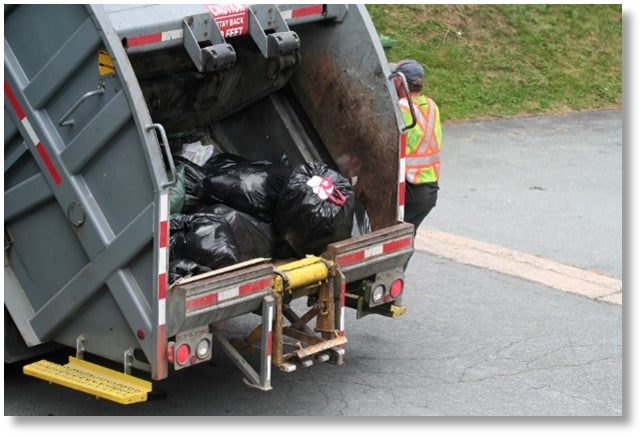Refuse Worker Safety
Refuse workers face unique injury hazards within their daily work duties. Workers jump on and off trucks, handle heavy loads, and may encounter dangerous materials. The most common cause of refuse worker fatalities continues to involve their truck. Learn more about how employers can keep these essential workers safe.
Data from the U.S. Department of Labor’s Bureau of Labor Statistics (BLS) 2021 National Census of Fatal Occupational Injuries identify refuse and recyclable materials collection as the seventh-deadliest occupation in the U.S.1 In 2021, refuse workers totaled over 79,000 nationwide.1 That same year almost 75% of workers experienced a work-related injury, illness, or fatality.1 Waste collection workers, also known as refuse workers, manage the collecting and disposing of solid waste material.

Refuse Workers are At Risk for Struck-by Incidents
Being struck by a passing motorists and crashes with other vehicles are other common causes of death for refuse workers.2 Struck-by incidents happen when a worker is hit by a passing motorist. Refuse workers are at risk for struck-by incidents when they stand or ride on the refuse collection truck riding step or work behind or around vehicles or traffic. Both situations increase the risk of injury and death from transportation incidents, particularly, struck-by incidents.
The most common cause of refuse worker fatalities continues to involve their truck.
What Employers Should Do:
- Select equipment appropriate for the task like automated side loader trucks.3
- Automated side loaders help improve safety by limiting exposure to hazards outside the truck (being struck by the truck or other vehicles), and hazards associated with manual lifting.3
- Make sure refuse collection trucks have audible alarms to alert workers and pedestrians when backing.
- Alarms need to be distinct from the surrounding noise level.2
- Alarms should activate before moving when the driver shifts into reverse.2
- Make sure refuse collection trucks are visible to motorists.
What Employers Should Communicate to Workers:
Moving to and from their collection Route:
- Ride only in the vehicle cab.3
- Wear a seat belt when traveling to or between collection routes.
- When seating is not available inside the cab, collectors should ride to and from the collection route by a separate vehicle.2
- Remain inside the vehicle cab until the vehicle is at a complete stop.3
Moving through their collection Route:
- Only ride on riding steps when moving forward short distances (0.2 mile or less) at slow speeds (10 miles per hour or less).2
- Do not ride on the steps when the vehicle is backing.2
- When the riding steps are in use, drivers and crew members should be alert for obstacles such as:
- Poles,
- Tree limbs,
- Parked vehicles, and
- Tight clearances that could injure step riders.2
- Wear high-visibility vests when working near active roadways for greater visibility.5
All workers and pedestrians should keep alert while near active roadways and maintain situational awareness. Motorists should be aware of refuse collection vehicles. When safe, motorist should move over to make room for refuse collection vehicles. Employers of refuse workers can help prevent struck-by incidents by selecting the appropriate equipment5, sharing safe riding techniques, encouraging situational awareness, and providing high-visibility vests for working along active roadways for greater visibility.1 All involved in refuse work need to be proactive while on the job to help prevent struck-by incidents. Share these safety recommendations with refuse workers to help keep them safe.
References
1 Waste worker fatalities climbed in 2022 – Waste & Recycling (wasterecyclingmag.ca)
2 Industries at a Glance: Waste Management and Remediation Services: NAICS 562 : U.S. Bureau of Labor Statistics (bls.gov)
3 It’s pretty dangerous to be a garbage man’ | June 2018 | Safety+Health (safetyandhealthmagazine.com)
4 eLCOSH : ANSI/ISEA 107-1999 American National Standard for High-Visibility Safety Apparel
5 FACE Program: In-house Report 2021-01 (cdc.gov/niosh)
